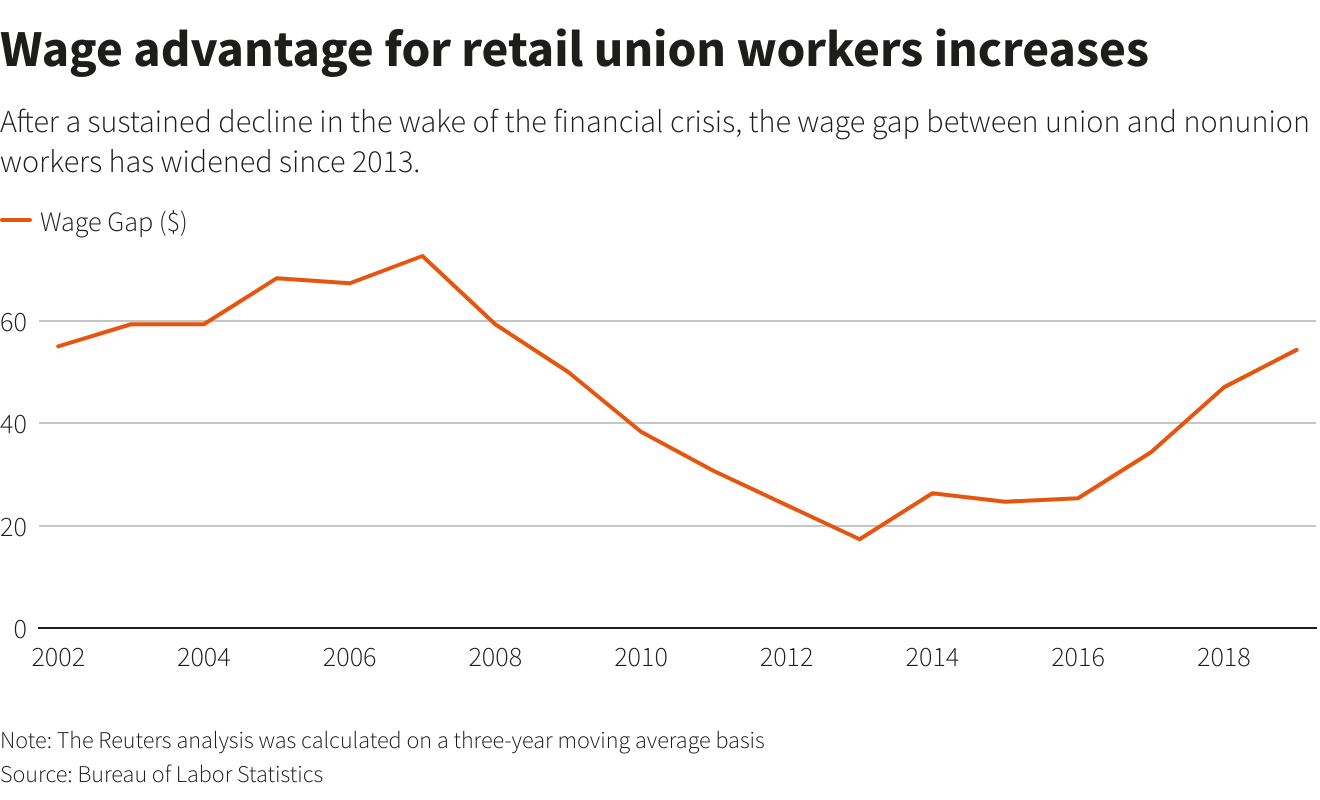“They (labor unions) have raised wages, shortened hours, and provided supplemental benefits. Through collective bargaining and grievance procedures, they have brought justice and democracy to the shop floor.” –John F. Kennedy
As the owner or manager of a retail business, you may be wondering what you can do to prevent unionization. First, it’s essential to recognize that certain things are permitted by law while others are not. This blog post will discuss what owners can do to legally discourage unionization. We’ll also provide tips on staying compliant with the law while reducing the appeal of union drives.
Business managers prefer a union-free workplace for three broad reasons. First, they don’t want an outside organization interfering with their autonomy. Second, they fear unions will cost more than they can afford. Lastly, a union will reduce a company’s ability to innovate, exploit technologies or re-organize business models over the long term. Here are a few additional reasons why businesses resist union organization:
- Reduced labor flexibility
- Union Members can Legally Strike
- Decrease Human Resources Control
- More Lawsuits and Arbitrations
- Extra Accounting for Union Dues
- Reduce the value of merit
Unions represent the interests of employees and can negotiate for better pay and working conditions as a group versus negotiating as individuals. Most importantly, union organizers are professionals at representing employees at the negotiation table. Thus, businesses often oppose unions because they can interfere with their autonomy or affect them economically.

The Labor Law framework: federal and state law
The United States constitution allows for concurrent jurisdiction between the federal and state (and municipal) governments in the area of labor law. This means that both levels of government can pass laws governing labor standards in the United States. However, via jurisprudence, when federal and state laws conflict, the law which provides the most protection for the worker will prevail.
USA – National Labor Relations Act 1935
In 1935, Congress passed the National Labor Relations Act (NLRA), clarifying the United States government’s policy of encouraging collective bargaining by protecting workers’ freedom of association. The NLRA protects workplace democracy by providing employees at private-sector workplaces the fundamental right to seek better working conditions and representation without fear of retaliation.
What is the Fair Labor Standards Act?
The Fair Labor Standards Act (FLSA) of 1938 requires a federal minimum wage, currently $7.25 but higher in 29 states and D.C. In addition, it discourages working weeks over 40 hours through time-and-a-half overtime pay. At present, no federal and few state laws require paid holidays or paid family leave.
Who is affected by the Fair Labor Standards Act?
The FLSA covers all employees under mandatory overtime provisions for overtime-eligible employees. It mandates that employees who work over 40 hours a week must be compensated with overtime pay or compensatory time. Additionally, overtime-eligible employees must complete a Time and Attendance record in order to comply with FLSA standards.
TimeWellScheduled ensures accurate pay, scheduling and legal compliance!
Why does unionization appeal to employees?
Employees join unions because they are dissatisfied with management and working conditions and believe that a union can remedy unfair labor practices and compensation. Compensation is controversial during a union organizing campaign. For example, wage increases entice employees to join a union when the company is perceived as unfair, unresponsive, or offering substandard working conditions.
According to the Utility Workers Union of American (UWUA):
- Union members earn better wages and benefits than workers who aren’t union members. On average, union workers’ wages are 28 percent higher than their nonunion counterparts.
- While only 19 percent of nonunion workers have guaranteed pensions, fully 78 percent of union workers do.
- More than 84 percent of union workers have jobs that provide health insurance benefits, but only 64 percent of nonunion workers do. Unions help employers create a more stable, productive workforce—where workers have a say in improving their jobs.
- Unions help bring workers out of poverty and into the middle class. In fact, in states where workers don’t have union rights, workers’ incomes are lower.
Labor unions give workers the power to negotiate for favorable working conditions and other benefits through the collective bargaining process. As a result, union members earn better wages and benefits than workers who don’t have union membership.
What can companies legally do to discourage unionization?
Important factors that contribute to it high levels of job satisfaction:
Respect (72%), meaningfulness (35%), salary (20%), autonomy (18%), opportunity (15%) and recognition (12%). (Zippia, 2022)
Creating a Stress-Free Working Environment
Work-related stress makes employees more prone to error, poor work performance, mental health issues, burnout, and conflict in the workplace. What’s more, if job stress remains unchecked, organizations will experience higher turnover, absenteeism, and an increased likelihood of unionization.
Three contemporary stressors that many workers experience:
-
- Firstly, work-related stress stems primarily from ever-increasing workloads. Companies today demand that employees cope with the heavier workload while working to tighter and tighter deadlines.
- Secondly, a significant source of stress in today’s workplace is the rapid pace of technological change. This often means that employees constantly have to get used to new devices, hardware, software, or technology, which can be frustrating and stressful.
- Finally, today’s lack of job security and the consequent worry about the future contribute to stress in the workplace. The best way to address this is for employers to show more commitment toward their employees.
Healthier employees operating under reasonable stress levels will be happier and more positive at work. This will maintain a robust and healthy workplace culture conducive to creativity and productivity and are less likely to become pro-union employees.
Recommended Reading: How can you reduce the stress of completing a project?
Open door management policies
In most companies, an open door management policy indicates to employees that a supervisor or manager is available to hear an employee’s questions, complaints, suggestions, and problems. The objective is to encourage open dialogue, feedback, and discussion about employees’ concerns. Other benefits include:
- Improves communication across all levels of the business.
- Enhances problem-solving between supervisors and employees
- Addresses employee concerns & challenges before they become problems
- Encourages constructive discussions
- Improves manager-employee relations
In sum, private-sector unions appeal to employees due to a lack of communication between the employer and workers. Businesses that regularly communicate with employees and provide opportunities to hear grievances are less vulnerable to unionization.
Job Satisfaction & Competitive compensation
Employers who set compensation at or above industry levels have a significant edge over employers who do not compensate their workers fairly.
- 68% of workers making more than $150,000 per year reported being “very satisfied” with their current job (CNBC, 2019)
- 40% of people making under $50,000 said the same.
- 61% view fair payroll as extremely important, job satisfaction (SeedScientific, 2022)
- 2% of American employees would leave their current job for a raise. (Zippia, 2022)
A competitive pay rate can influence an employee’s overall job satisfaction. Workers that feel they are receiving fair compensation feel valued, motivated, and committed to achieving company objectives. Further, competitive salaries reduce turnover and increase morale and overall job satisfaction.
Employee trust and recognition
Workplace recognition motivates, provides a sense of accomplishment, and makes employees feel valued for their work. Recognition not only boosts individual employee engagement but has also increased productivity and loyalty to the company, leading to higher retention.
Employees who experience employer recognition for their efforts are:
- 44% more satisfied with their job and employer than unrecognized employees.
- 73% more productive and less likely to experience burnout
- 4x as likely to be actively engaged at work than unrecognized coworkers.
- 5x more committed to their workplace culture and organizational objectives.
Involve The Staff in The Decision Making Process.
Participative Management (PM) is a management style that requires the cooperation of both managers and employees. The aim is to enhance commitment and motivation toward achieving company objectives. To do this, the manager must willingly delegate decision-making authority over projects, tasks, processes, and problem-solving.
-
- 75% of employees quit their boss, not their job. (SeedScientific, 2022)
- Workers whose input is encouraged and appreciated are four times as likely to be more productive. (SeedScientifc, 2022)
Employee involvement in decision-making shows those across the organization that their opinion is valued and trusted. Furthermore, employees feel a part of the organization and thus take responsibility for their work and push themselves to find better results. This enhances the possibilities of innovative thinking and ideas to solve problems and reduces the perceived value of union representation.
Here are some additional examples of how employees can participate in organizational leadership and decision-making:
-
- Involve employees in setting project goals, business processes, or sales targets.
- Allow employees to set performance expectations and objectives.
- Implement profit sharing to enhance motivation and encourage accountability
- Allow employees to participate in the scheduling process; TimeWellScheduled can facilitate this process seamlessly. Click here to learn more.
When employees are involved in the decision-making process, the organization creates an opportunity for team members to share ideas, learn from each other, and work toward a common goal. In turn, a collaboration culture forms and helps break down organizational silos and group think. Finally, when employees feel empowered within a company, the appeal of unionization diminishes as it could be perceived as a threat to their autonomy.
Common Sense Dos and Don’ts for Union-Allergic Managers
The acronym TIPS can help remind employers not to:
- Threaten—never threaten to retaliate against employees by terminating them or reducing pay or benefits.
- Interrogate—do not interrogate employees about their activities or the activities of coworkers.
- Promise—do not promise anything to employees, such as promotions or benefits, in exchange for not supporting the union.
- Surveillance/Spying—never spy on union activities. Employees have the right to meet with the union representatives and “hear them out” without management interference.
Regardless of one’s views on unionization, without the work undertaken by trade unions, there would be no laws governing maximum working hours, no health & safety regulations, no personal protective equipment, no lifting and manual handling regulations, no sick pay, and no right to paid breaks. In short, the worst elements of capitalism would manifest itself in the form of workplace exploitation and a low quality of life.
It may not be possible to prevent unionization. However, it should be the goal of employers within reason to replicate a unionized environment to lessen the appeal of union organizing drives. By understanding your employees and responsibilities under labor law, owners and managers can satisfy employees, protect their business while remaining in compliance with federal and state labor laws and at the same time avoiding unionization.
Thank you for reading our article!
TimeWellScheduled.com is a secure, online time and attendance software that is 100% tailored to meet your scheduling needs! In addition, TimeWellScheduled facilitates employee attendance tracking, payroll administration and enhances your staff management capabilities. Plus, our service is free for up to 10 employees!
Click: here to download our (Excel) employee scheduling template; It’s FREE!





